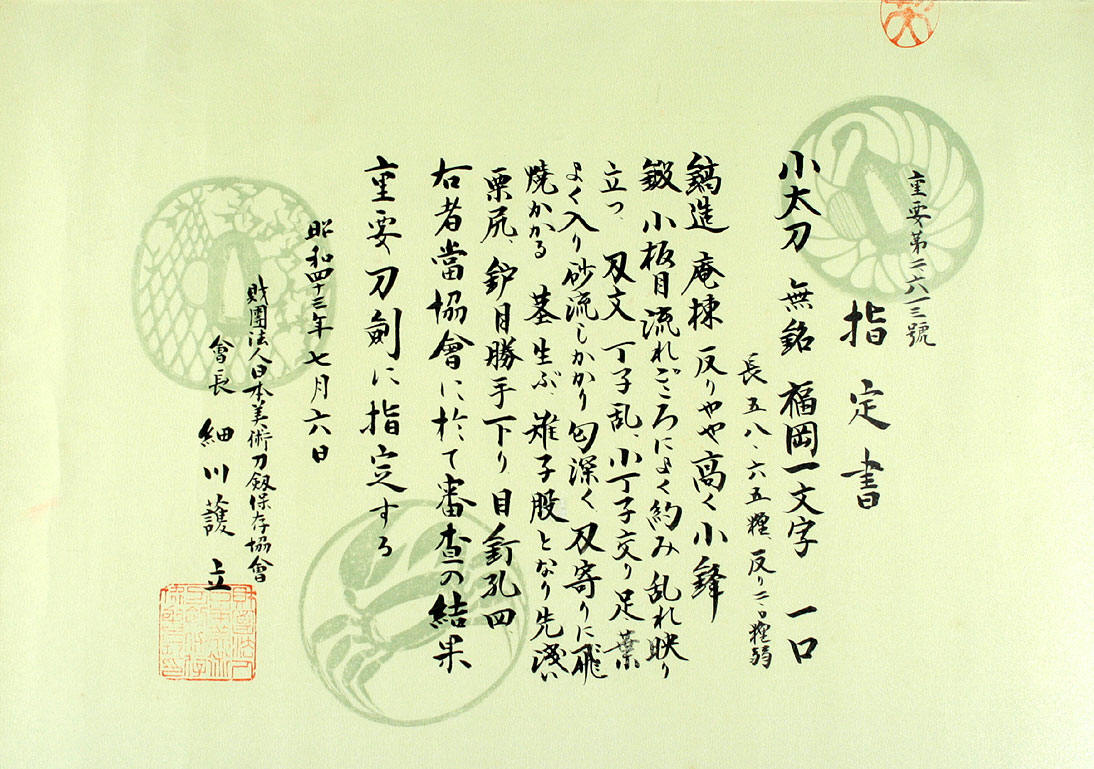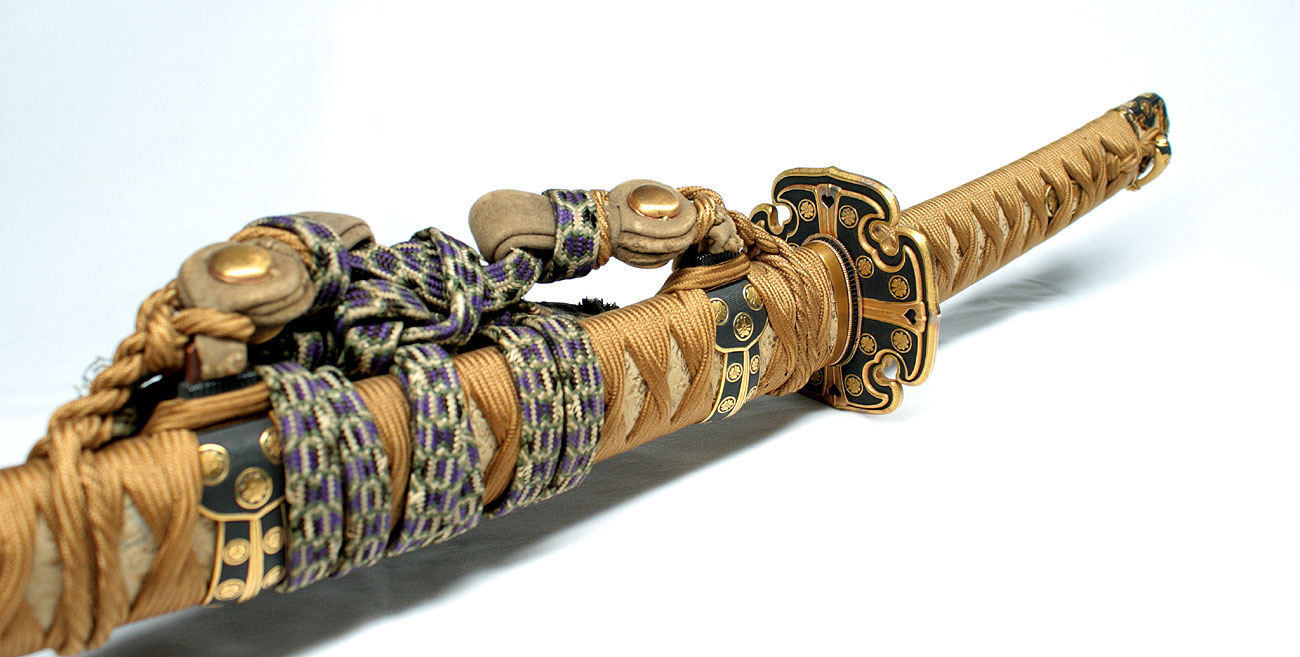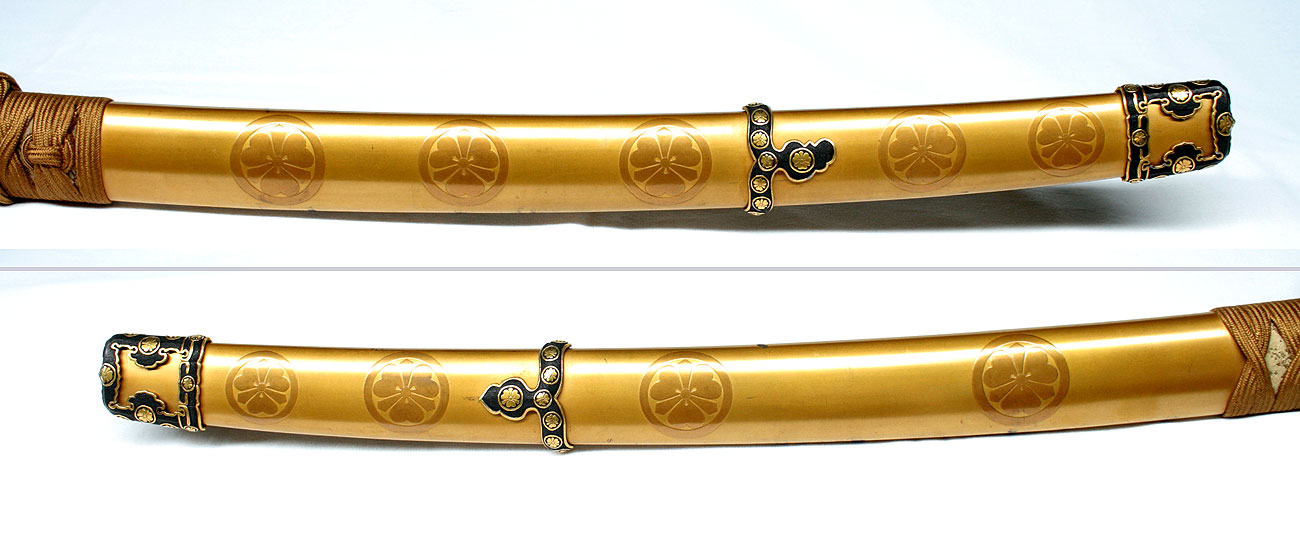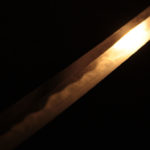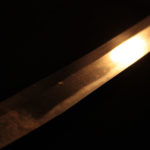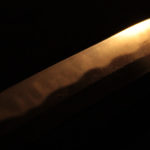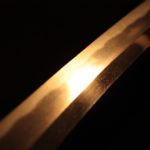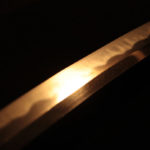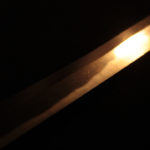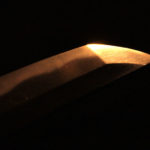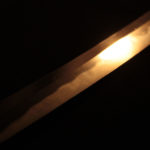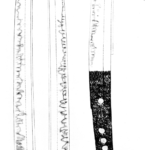Gallery Page (Display Only)
Mid Kamakura period…
partial Kiku mon remaining*
w/ fine Itomaki tachi & Ikakeji (gold lacquer) saya
and Sakai clan family crest (mon)
NBTHK Juyo Token
Description
This is an impressive blade by Fukuoka Ichimonji made during the mid Kamakura period.
*There is a partially obscured kiku-mon (chrysanthemum), see further below with image of tang showing detailed close up, after 800 years or so it has mostly worn away and or been covered with patina. There are few blades by Fukuoka Ichimonji with Kiku-mon (chrysanthemum).
The Itomaki saya with the family crest of “Sakai” has gold “Ikakeji” which is lacquerware thickly coated with gold dust and polished to look like gold. Gold-nashiji or gold-ikakeji was restricted to owners of the third court-rank and higher. We believe this Itomaki tachi koshirae was made during end of Edo.
Please see detailed specifications further below.
To the collector, the fact that this was granted NBTHK Juyo certification July 6th
1968
is highly significant. Juyo blades judged prior to 1971 are considered to be more prestigious because there was no higher ranking at the time (
NBTHK Tokubetsu Juyo did not yet formally exist
).
Swords awarded Juyo Token from this extremely selective period were of the absolute
top rank and are thus highly coveted. This was the Tokubetsu Juyo of its day.
Juyo Zufu paper and translation
17 th Juyo – July 6th, 1968
length : 58.65cm
curvature : 2.0cm
basis width : 2.45cm
top width : 1.65cm
kissaki length : 2.45cm
nakago length : 14.95cm
nakago curvature : 0.2cm
shape : Shinogi-zukuri, Ihorimune, Ubu-nakago, Slightly a curve, Ko-kissaki
ji : Ko-itame closely and slight stream, Midare-utsuri
ha : Choji-midare, O-choji, Ko-choji, Ashi, Yo, Sunagashi, Nioi deeply, Tobiyaki near the ha
boshi : Slightly wavy, Ko-maru, Back side ko-maru with Hakikae
nakago : Ubu, Kijimomo shape, Kurijiri, Yasurimei is Kattesaki, 4 mekugi ana
The work before the mid Kamakura period. Gorgeous Ji and Ha Relatively wholesome.
Brief history of high ranking Sakai family members
Sakai Tadakatsu (July 21, 1587 – August 25, 1662), also known as Sanuki-no-kami and Minamoto-no Tada katsou, was tair?, r?j?, master of Wakasa-Obama castle and daimyo of Obama Domain in Wakasa province in the mid-17th century. As tair?, he was one of the two highest ranking bakufu officials in Tokugawa Japan from his elevation on November 7, 1638 through May 26, 1656. The Sakai were identified as one of the fudai or insider daimy? clans which were hereditary vassals or allies of the Tokugawa clan, in contrast with the tozama or outsider clans.
Sakai wakasa-no-kami TADAYOSHI (August 4, 1813 – December 5, 1873), also known as Sakai Tadaaki, was a Japanese daimyo of the Edo period, and he was a prominent shogunal official. He was also known as Sh?ri-daibu (1834; and again in 1850); as Wakasa-no-kami (1841); and Uky?-daibu (1862). He would become Obama’s last daimy?, holding this position until the feudal domains were abolished in 1871. Tadaaki was briefly a Magistrate of Temples and Shrines, before becoming the Tokugawa shogunate’s forty-eighth Kyoto shoshidai for the period spanning December 23, 1843 through September 4, 1850.
Castle of Obama - Wakasa province
Obama Castle: is classified as a flatland castle (its layout: Rinkakushiki), and is located in Fukui Prefecture. During the pre-modern age, it found itself within the borders of Wakasa Province. It is associated with the Ky?goku, Sakai clans. Approximate dates in use: 1601 – 1871.
Almost completely surrounded by water, the setting of this castle is just fantastic. It sits on the shores of the Sea of Japan, on a needle-like peninsular formed by two rivers. Classified as a Flatland castle, it easily satisfies the criteria of Water castle. The original castle was quite a compact site with a large number of turrets, bridges & gates. It was one of a select group of castles that had retained its main tower for most of the Edo period.
Nowadays, the castle is all but forgotten. The stonework of the inner-most enclosure has survived to the present and sits amongst a crowd of houses.
The domain’s capital of Obama was a prosperous port city throughout much of the 15th-17th centuries, though it gradually became a quiet provincial castle town later in the Edo period. Still, it was an important link in the domestic sea routes between Ezo and the Sea of Japan coast, and played a significant role in the economic development of the early Edo period.
In the Sengoku period, Obama was controlled by a succession of lords, including members of the Takeda clan, followed by Niwa Nagashige, Asano Nagamasa, and others, including Kinoshita Katsutoshi. In 1600, Kinoshita did not participate in the decisive battle of Sekigahara in 1600, but he was deprived of Obama because he had not actively supported the winning side.[4]
In 1600, Ky?goku Takatsugu was established at Obama.[5] In part, this was a reward for his leadership during the Siege of ?tsu. In the same week as the Battle of Sekigahara, Takatsugu did fail to hold the Castle of ?tsu; but the outcome at Sekigahara marginalized any adverse consequences of his defeat. In moving Takatsugu to Obama, the shogunate effectively acknowledged that Tadatsugu role in the victory at Sekigahara was critical. The siege siphoned men away from the massed array of forces the Tokugawa faced at Sekigahara. In other words, this meant that the attackers at ?tsu were unavailable to augment the anti-Tokugawa fighters at Sekigahara.[6]
In 1607, Tadatsugu’s son Tadataka was married to the fourth daughter of Shogun Hidetada. Two years later, Tadataka became daimyo when his father died in 1609. Tadataka would remain at Obama until 1634; and then the bafuku ordered him to move to Matsue Domain in Izumo Province.[5]
Sakai Tadakatsu, formerly of the Sakai clan at Kawagoe Domain in Musashi Province, then became lord of Obama.[7] Sakai was one of the shogunate’s top officials, serving on the r?j? council, and later as its head, or Tair?. He was succeeded in the domain by his fourth son, Sakai Tadanao.
Tadanao distributed out parts of his income to create new domains. The 10,000 koku domain of Katsuyama in Awa Province was thus established for his nephew in 1668, and the 10,000 koku domain of Tsuruga in Echizen Province was created in 1682 by his son. After another 3000 koku was given to Tadanao’s fifth son Sakai Tadane, the domain was reduced to 103,500 koku.
Tadakatsu had done a lot to establish the domain’s governance and to ensure its strength and stability. He implemented a taxation system, and installed town magistrates (machi-bugy?) and local governors. However, a flood ravaged the domain in 1735, and famine set in, as it did in many other areas at this time. The peasants sought aid from their lord, but their cries went unheeded for a long time. In 1770, there was an outright peasant revolt. Efforts were made to shore up the domain’s finances and to relieve the peasant’s suffering, but famine struck again several decades later in 1836.
The twelfth Sakai lord of Obama, Sakai Tadaaki, was also the shogunal deputy in Kyoto (Kyoto shoshidai). He worked with Ii Naosuke to effect the Ansei Purges, links between the shogunate and the Imperial Court, and the suppression of the revolt of Takeda K?unsai. In 1868, he fought for the shogunate in the Boshin War; defeated, he was nevertheless returned to his post at Obama, under the new name Sakai Tadayoshi. When the daimy? were eliminated in 1869, he became governor of Obama; two years later, the han (feudal domains) were abolished, and Obama became a prefecture. It was absorbed into Shiga Prefecture in 1876, and into Fukui in 1881.
The Koshirae
“Ikakeji saya kamon chirashi Itomaki tachi koshirae”
The Blade
This Sword is not available for purchase.
If you wish to purchase a Japanese Sword, please view our Nihonto for sale page or contact us directly via email or by telephone at 1(608) 315-0083 any time. Please include specifics of what you seek, i.e.: Katana, maker, era, price range, etc.
Pictures and content may not be copied without the express permission of samuraisword.com ©





